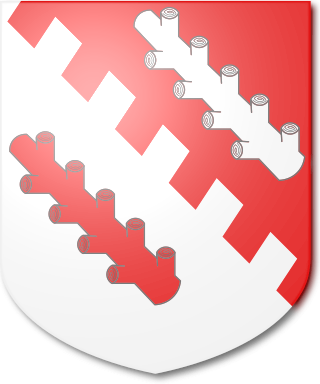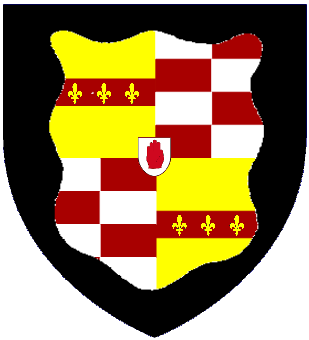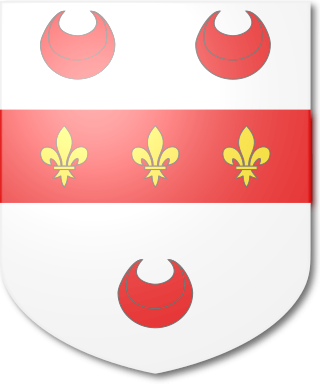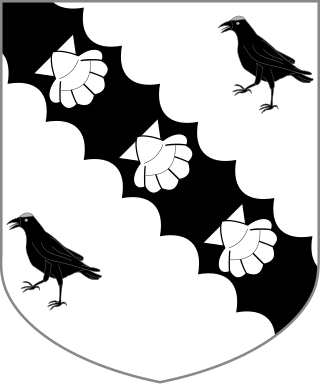
Viscount Hardinge, of Lahore and of Kings Newton in the County of Derby, is a title in the Peerage of the United Kingdom. It was created in 1846 for the soldier and Tory politician Sir Henry Hardinge. His son, the second Viscount, represented Downpatrick in Parliament. His great-great-grandson, the sixth Viscount, succeeded a distant relative as eighth Baronet, of Belle Isle in the County of Fermanagh, in 1986. This title had been created in the Baronetage of the United Kingdom 1801 for Richard Hardinge. He was the third son of Nicolas Hardinge, younger brother of Reverend Henry Hardinge and uncle of the latter's third son Henry Hardinge, 1st Viscount Hardinge. The baronetcy was created with special remainder to the heirs male of Richard Hardinge's father.

Charles Theophilus Metcalfe, 1st Baron Metcalfe,, known as Sir Charles Metcalfe, Bt between 1822 and 1845, was a British colonial administrator. He held appointments including acting Governor-General of India, Governor of Jamaica and Governor General of the Province of Canada.

The Hobhouse Baronetcy, of Chantry House in the parish of Bradford-on-Avon in the County of Wiltshire and of Westbury College in the County of Gloucester, is a title in the Baronetage of the United Kingdom. It was created on 22 December 1812 for Benjamin Hobhouse, a wealthy brewer and member of parliament for Bletchingley, Grampound and Hendon. His eldest son, the second Baronet, was a prominent writer and Liberal politician and notably served as Chief Secretary for Ireland and as President of the Board of Control. In 1851 he was raised to the peerage as Baron Broughton, of Broughton-de-Gyffard in the County of Wiltshire. However, he had no sons and on his death the barony became extinct, while he was succeeded in the baronetcy by his nephew, the third Baronet. The latter's son, the fourth Baronet, was also a noted Liberal politician and held office as Chancellor of the Duchy of Lancaster and as Postmaster General.

The Strachey baronetcy, of Sutton Court in the County of Somerset, England, is a title in the Baronetage of the United Kingdom. This family was originally seated at Walden, Essex, where William Strachey was living under the rule of Edward VI. Later they moved to Surrey and at last settled at Sutton Court, Somerset. The title was created on 15 June 1801 for the politician and civil servant Henry Strachey. Sir Henry was private secretary to Lord Clive during his last expedition to India in 1764. He also took part in negotiations for peace with North America where he assisted the kings commissioners at Paris. He died in 1809 and was succeeded by his eldest son Henry, the second Baronet Strachey. His great-grandson, the fourth Baronet, was a Liberal politician. On 3 November 1911, he was created Baron Strachie, of Sutton Court in the County of Somerset, in the Peerage of the United Kingdom. He later served as Paymaster General. The peerage became extinct on the death of his son, the second Baron, in 1973. The baronetage is currently dormant.

There have been two baronetcies created for members of the Jessel family, both in the Baronetage of the United Kingdom. One creation is extant as of 2012.

There have been two baronetcies created for persons with the surname Backhouse, once in the Baronetage of England and once in the Baronetage of the United Kingdom. As of 2023 one creation is extant.

The Boyle Baronetcy, of Ockham in the Parish of Salehurst in the County of Sussex, is a title in the Baronetage of the United Kingdom. It was created on 14 December 1904 for Edward Boyle, a barrister, businessman and Conservative Member of Parliament for Taunton. His grandson, the third Baronet, was also a Conservative Member of Parliament and ultimately cabinet minister serving as Minister of Education from 1962 to 1964. He was made a life peer as Baron Boyle of Handsworth, of Salehurst in the County of Sussex, in 1970 and became vice-chancellor of the University of Leeds in the same year. The life peerage became extinct on his death in 1981 and he was succeeded in the baronetcy by his younger brother, the fourth Baronet. As of 2024 the title is held by the latter's eldest son, the fifth Baronet, who succeeded in 1983.

The Barrett-Lennard Baronetcy, of Belhus in the County of Essex, is a title in the Baronetage of the United Kingdom. It was created on 30 June 1801 for Thomas Barrett-Lennard, subsequently Member of Parliament for Essex South. He was the illegitimate son and testamentary heir of Thomas Barrett-Lennard, 17th Baron Dacre. He was succeeded by his grandson, the second Baronet, the son of Thomas Barrett-Lennard, Member of Parliament for Maldon. His son, the third Baronet, was childless and was succeeded by his younger brother, the fourth Baronet. This line of the family failed on the death in 1977 of his son, the fifth Baronet, who died without male issue. The late Baronet was succeeded by his third cousin once removed, the sixth Baronet. He was the son of Sir Fiennes Cecil Arthur Barrett-Lennard, Chief Justice of Jamaica, son of Captain Thomas George Barrett-Lennard, son of the first marriage of George Barrett-Lennard, son of John Barrett-Lennard, second son of the first Baronet. The sixth Baronet was a Catholic clergyman. As of 2014 the title is held by his second cousin, the seventh Baronet, who succeeded in 2007. He is the grandson of Trenchard Barrett-Lennard, son of the aforementioned George Lennard-Barrett by his second marriage. As of 31 December 2013 the present Baronet has not successfully proven his succession and is therefore not on the Official Roll of the Baronetage, with the baronetcy considered vacant since 2007.
The Langham Baronetcy, of Cottesbrooke in the County of Northampton, is a title in the Baronetage of England. It was created on 7 June 1660 for John Langham, Member of Parliament for the City of London in 1654 and for Southwark in 1660 and 1661. The second Baronet was Member of Parliament for Northamptonshire and Northampton while the third Baronet sat for Northampton. The seventh Baronet was Member of Parliament for Northamptonshire. The tenth Baronet represented St Germans in the House of Commons. The thirteenth Baronet was a photographer, ornithologist and entomologist and served as High Sheriff of County Fermanagh in 1930.
The Makins Baronetcy, of Rotherfield Court in Henley-on-Thames in the County of Oxford, was a title in the Baronetage of the United Kingdom. It was created on 9 January 1903 for William Makins, Member of Parliament for South Essex, South East Essex and Walthamstow. The title became extinct on the death of the fourth Baronet in 1999.
There have been four baronetcies created for persons with the surname Bell, all in the Baronetage of the United Kingdom. One creation is extant as of 2007.

The Huntington-Whiteley Baronetcy, of Grimley in the County of Worcester, is a title in the Baronetage of the United Kingdom. It was created on 8 February 1918 for Herbert Huntington-Whiteley, Conservative Member of Parliament for Droitwich.

The Oakeley Baronetcy, of Shrewsbury, is a title in the Baronetage of Great Britain. It was created on 5 June 1790 for the Indian administrator Charles Oakeley. He served as Governor of Madras from 1790 to 1794. Frederick Oakeley was the second son of the first Baronet.
The Nepean Baronetcy, of Bothenhampton in the County of Dorset, was a title in the Baronetage of the United Kingdom. It was created on 16 July 1802 for the politician and colonial administrator Evan Nepean. He was Chief Secretary for Ireland from 1804 to 1805 and Governor of Bombay from 1812 to 1819. The title became extinct on the death of the sixth Baronet in 2002. Another member of the family to gain distinction was Herbert Evan Charles Bayley Nepean (1865–1951), son of Colonel Herbert Augustus Tierney Nepean, son of Reverend Evan Nepean, fourth son of the first Baronet. He was a Brigadier in the Indian Army. Lieutenant Colonel Evan Yorke Nepean, the 6th Baronet, was notable for having the amateur radio callsign AC4YN. With Hugh E. Richardson on a political mission to Tibet in 1936, he took this call based on his own initials and the AC4 prefix, which at that time was assigned to this country. It is famous as one of the rarest amateur stations.

The Parkyns Baronetcy, of Bunny Park in Nottinghamshire, is a title in the Baronetage of England. It was created on 18 May 1681 for Thomas Parkyns in acknowledgement of the royalist service of his father Colonel Isham Parkyns during the English Civil War.
Sir Thomas Theophilus Metcalfe, 1st Baronet, was a British soldier and politician.
Sir Theophilus John Metcalfe, 5th Baronet (1828–1883) was a British Bengal civil servant of the East India Company. He is noted for his part in the 1857 Indian Rebellion, and his vindictive behaviour in the aftermath.

The Stapleton Baronetcy, of the Leeward Islands, is an extinct title in the Baronetage of England. It was created on 20 December 1679 for William Stapleton, who followed Charles II into exile in France, and after the Restoration was appointed deputy-governor of Montserrat and captain-general of the Leeward Islands.

The Rowley baronetcy, of Hill House in the County of Berkshire, was created in the Baronetage of the United Kingdom on 21 March 1836 for the naval commander Admiral Charles Rowley. He was the fourth son of the 1st Baronet of the 1786 creation.
The Waller baronetcy, of Braywick Lodge in the County of Berkshire, was created in the Baronetage of the United Kingdom on 30 May 1815 for Wathen Waller, Groom of the Bedchamber to the Duke of Clarence and St Andrews. The 3rd Baronet was a major general.













